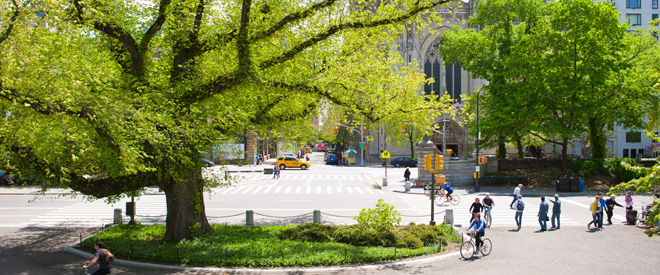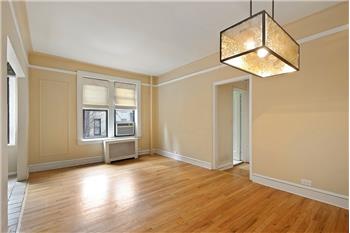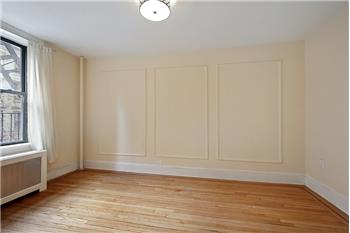Living in Carnegie Hill
The Carnegie Hill section of Manhattan, full of magnificent townhouses rarely for sale, has convenient access to Central Park. Larger buildings house prewar apartments of six or seven rooms, known as “Classic Sixes” and “Classic Sevens.” The light in the area remains generous though, as even these magnificent co-ops are usually modest in height. The resulting old-world feel, which influences even modern condos in Carnegie Hill, illustrates why steel tycoon Andrew Carnegie selected this quiet, countrified section of Manhattan as the place to build his ultimate family home. (You can still visit it today on your way to buy or rent an apartment — it’s now a branch of the Smithsonian known as the Cooper-Hewitt museum.)
With Central Park on its doorstep, Carnegie Hill is a quiet residential oasis in Manhattan’s Upper East Side. Dignified mansions sit next to chic bakeries and bustling Italian restaurants. The neighborhood’s wealth of cultural institutions, elite schools and historic architecture makes it a sublime place to live for its genteel residents.
There tends to be very little turnover in Carnegie Hill because once new residents arrive, they quickly fall in love with the intimate atmosphere and picturesque cityscapes. Neighbors greet one another as they run local errands, and shopkeepers build relationships with their regulars. What’s more, midtown and lower Manhattan are within easy reach, with Subway lines 4, 5 and 6 passing through the neighborhood.
CARNEGIE HILL REAL ESTATE
Being one of New York’s most prestigious zip codes, Carnegie Hill real estate is highly sought-after. Park Avenue features rows of French and Italianate apartment houses with four-star doorman luxury. Spacious brownstones and prewar apartments give the neighborhood a distinct old-world ambience. A number of Carnegie Hill apartments are ‘Classic Sixes’ or ‘Classic Sevens,’ consisting of six or seven rooms including a formal dining area and one or two bathrooms.
Carnegie Hill Neighbors is a local group dedicated to preserving the area’s historic charm. Thanks to them, row houses on the area’s quiet side streets have been lovingly restored right down to their original architectural details. In this neighborhood you’ll see ornate gables and carvings on building exteriors, combined with well-groomed gardens and modern luxury interiors.
CARNEGIE HILL HISTORY
Named after entrepreneur Andrew Carnegie, Carnegie Hill's history is centuries-long. It was once home to the Wickquasgeck Native American tribe, before its conversion into Dutch farmland in the 17th century. When Central Park was established in the late 1800s, New York’s upper crust began to build their mansions along its edges, including Andrew Carnegie. He also purchased more land than he needed on 90th and 91st Streets in order to help shape the surrounding area.
At this time, Fifth Avenue was one of the most desirable thoroughfares due to its park-side location, which meant it retained a bucolic atmosphere in the midst of the city. Over the following decades, the avenues spreading away from the park quickly became lined with new apartment blocks, hotels and shops.
CARNEGIE HILL RESTAURANTS
There’s a varied selection of restaurants in Carnegie Hill, mostly located on the main avenues. Upscale Italian is heavily represented, such as Vico Ristorante and Paola’s on Madison Avenue. And some of the best restaurants are within Carnegie Hill’s museums. You can dine on New American in a sleek modern environment at the Wright at the Guggenheim, or indulge in Italian pastries and espresso from Tarallucci e Vino at Cooper Hewitt.
Famed for its scrumptious brunch, Sarabeth’s has been dishing up lemon and ricotta pancakes and mimosas to a well-heeled Carnegie Hill crowd since 1983. Pascalou is another favorite brunch destination, with a menu helmed by French chef Pascal Bonhomme. This intimate bistro has been a neighborhood landmark ever since it was the Carnegie Hill Café, run by Pascal’s future wife Lottie Baglan. The cuisine here is a labor of love, featuring classic French dishes like cassoulet along with internationally-influenced flavors from tagine to mole sauce.
CARNEGIE HILL ATTRACTIONS
Museum Mile is a picturesque stretch of tree-lined sidewalk along Fifth Avenue. A good portion of it passes through Carnegie Hill between 86th and 96th streets, nestled up against the greenery of Central Park. The Neue Galerie Museum for German and Austrian Art, National Academy Museum and School of Fine Arts, and the Jewish Museum are all located here.
Housed in a modernist masterpiece designed by Frank Lloyd Wright, the Solomon R. Guggenheim Museum is hard to miss. The striking building is cylindrical and grows wider as it climbs into the sky. Its gallery, which spirals up from the ground towards its glass dome ceiling, showcases works from artists like Picasso, Van Gogh and Giacometti on each level.
Another cultural highlight is the Cooper-Hewitt National Design Museum. Part of the Smithsonian Institution, the permanent collection here spans thirty centuries of design. From 17th-century embroidered men’s waistcoats to original architectural sketches of New York landmarks, this museum is a must-visit for anyone with an eye for detail. The museum itself is located in Andrew Carnegie’s former mansion. Constructed between 1899 and 1902, it’s a stunning example of Georgian architecture, with 64 light-filled rooms and a lush private garden.
CARNEGIE HILL SHOPPING
You can expect a thriving mix of national stores, fashion-forward boutiques and independent shops in Carnegie Hill. Residents often enjoy personalized service from neighborhood establishments that cater to a local clientele. Third Avenue offers a more diverse mix of chain stores and big-name retailers, while small grocers, designer showrooms, florists and charming bakeries line Madison Avenue.
The Corner Bookstore is the prime example of a well-established neighborhood retailer. Located in an 1890s brick-and-brownstone building that once housed a pharmacy, the bookstore retains meticulously restored interior details including its tinned ceiling and terrazzo floor. Vibrant geraniums and hanging ivy frame the entrance, while the inventory covers a broad range of genres.
S. Feldman Housewares is billed as “Carnegie Hill’s one-stop shop since 1929.” Whether you’re in the market for a light bulb or a set of Le Creuset cookware, you’re sure to find it here.
CARNEGIE HILL NIGHTLIFE
Carnegie Hill residents can enjoy their very own night at the museum at Guggenheim’s Art after Dark series, featuring live music and special exhibitions in the evenings. The 92nd Street Y is also a cultural hub for the neighborhood, with a packed calendar of events including film screenings, concerts and literary readings.
Bars in Carnegie Hill are usually of the sophisticated wine-tasting variety. Eli’s Essentials and Wine Bar is the Carnegie Hill branch of Eli Zabar’s delicatessens. There’s a carefully selected wine list from Zabar’s cellars on hand, with over 20 vintages available by the glass every evening until 1am. Soak up wine knowledge from the expert staff paired with small dishes from the accompanying seasonally-influenced menu.











